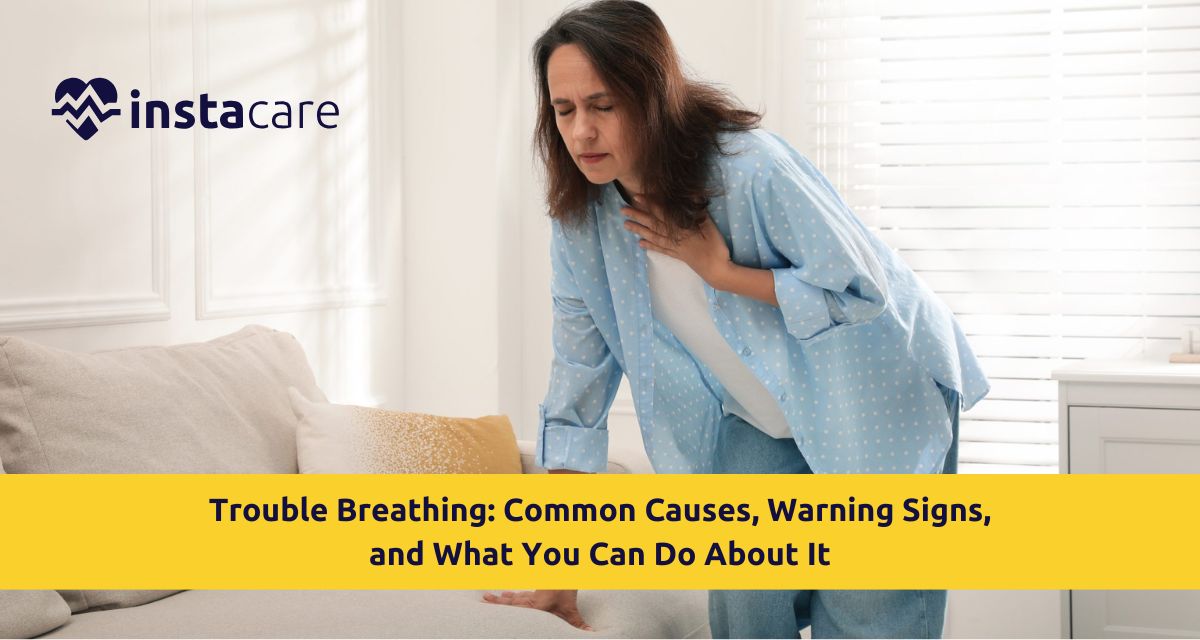What is Trouble Breathing?
Common Causes of Trouble Breathing
- Respiratory Disorders: Wheezing and shortness of breath with exposure to cold air, exercise, especially with allergens are expressions of asthma. COPD causes decreasing effort of breathing, especially with exercise. Pneumonia and bronchitis lead to inflammation, which interrupts oxygen exchange.
- Cardiac Problems: Supine dyspnea is usually a result of cardiac failure resulting from fluid overload in the lungs. Exertional dyspnea can be caused by coronary heart disease. Shortness of breath causes and chest pain are symptoms of heart attack.
- Anxiety and Panic Disorders: Compulsive binding with hard breathing. Choked and panicked breathing and hyperventilation with attacks in spite of sufficient oxygenation. Chronic tension results in chronic hypersensitivity to tension and breathing.
- Obesity: Excess weight hinders expansion of lungs and is a reason for excess requirement of oxygen, and therefore breathing becomes more labored breathing, particularly on effort or in the recumbent position.
- Anemia: Decreased number of red blood cells reduces capacity for carrying oxygen and leads to breathlessness with usual activity by body compensation for decreased oxygen.
- Pulmonary Embolism: Pulmonary emboli on the basis of arterial emboli result in sudden shortness of breath related to pain and tachycardia if immediate medical care is not given.
- Allergic Reactions: Hypersensitivity production, and inflammation of the airway is produced by it and results in constricting tightness and breathlessness and anaphylaxis maybe.
When to Seek Immediate Medical Attention
- Severe shortness of breath without apparent cause or sudden shortness of breath getting worse
- Chest tightness and difficulty breathing
- Blue or gray fingers, face, or lips (cyanosis)
- Shortness of breath or wheezing with sentence speech
- Abnormality of consciousness, confusion, or excessive somnolence
- Fever with dyspnea
- Swelling of tongue, throat, or face
- Shortness of breath on trauma, strangulation, or allergy
Diagnosis: How Doctors Identify the Cause
Diagnostic Tests:
- Pulmonary function tests assess lung capacity and airflow and diagnose obstructive or restrictive lung disease
- Chest X-rays radiates lung architecture, such as pneumonia, water, or structural disease
Blood Tests:
- Complete blood counts reveal infection or anemia
- Arterial blood gases reveal oxygen and carbon dioxide, assessing respiratory function effectiveness
Cardiac Evaluation:
- Electrocardiograms (ECG) reveal heart rhythm abnormality
- Echocardiograms reveal information regarding heart structure and function, revealing heart failure or valve disease
Specialized Testing:
- Stress tests during exercise reveal chronic shortness of breath with exercise
- Sleep studies reveal nocturnal shortness of breath with sleep apnea
Read More: Pursed Lip Breathing: How to Perform It, Its Advantages, and When to Do It
What You Can Do: Home Care and Medical Treatment?
Relief Measures Temporarily
Medical Management:
- Asthma is managed with bronchodilators and steroids that dilate airways and cause less inflammation
- COPD is managed with pulmonary rehabilitation, bronchodilators, and steroids
- Heart failure is managed with medications decreasing fluid overload and augmenting contractility of the heart
Oxygen Therapy
Anxiety Control
Modification of Lifestyle:
- Reduction of weight improves breathing substantially in obese patients
- Abstinence from smoking is an absolute necessity to be avoided in symptomatic patients with respiratory derangements
- Gradual increase in exercise, with initiation under strict medical supervision, develops and augments endurance of respiratory muscles
Preventing Trouble Breathing
- Avoid Triggers: Restrict and label exposure to symptom-provoking allergens, irritants, and toxins. Employ indoor air cleaners and monitor air quality prognostics before going outdoors.
- Medication Use: Follow medication use, using prevention inhalers on a daily basis instead of symptomatically.
- Healthy Body Weight: Maintain at and achieve healthy body weight through proper nutrition and regular exercise.
- Get Vaccinated: Stay Up to Date on Vaccines: Influenza and pneumococcal vaccinations protect against shortness of breath caused or triggered by respiratory illness.
- Add Regular Medical Monitoring: Regular medical monitoring of asthma, COPD, heart disease, or other chronic disease averts complications and maximizes treatment.
- Add Breathing Exercises: Diaphragmatic and pursed-lip breathing maximizes respiratory economy and reduces effortful bursts of breathing.
Conclusion

